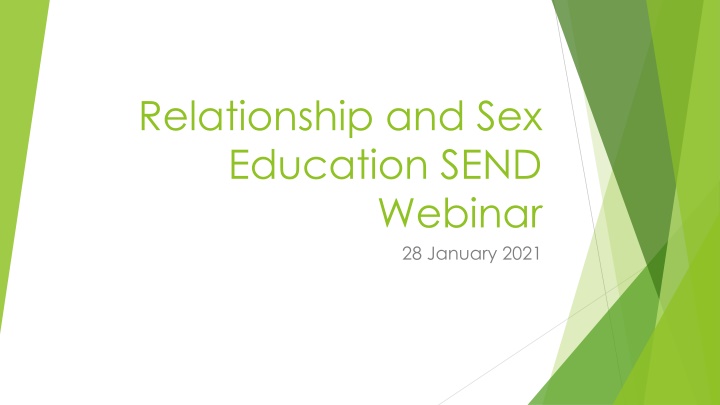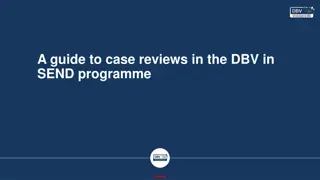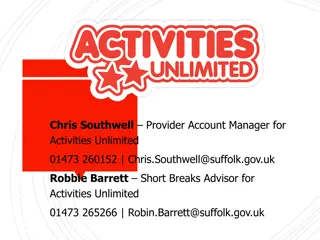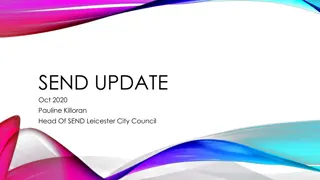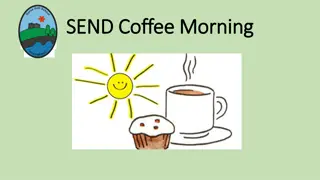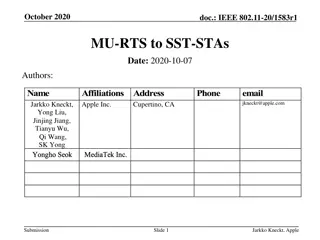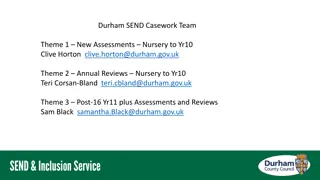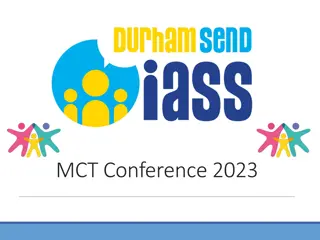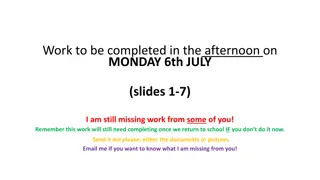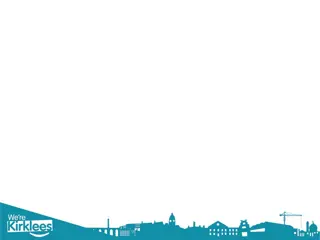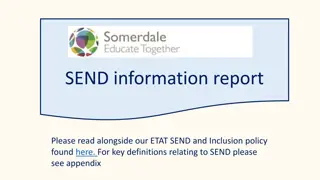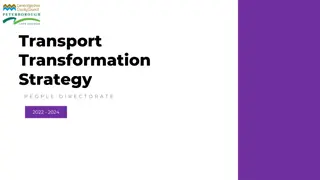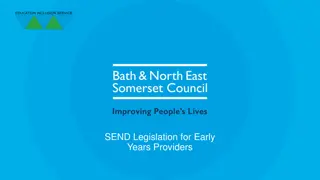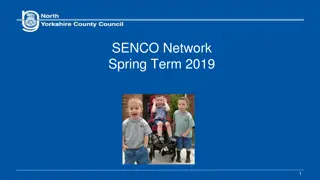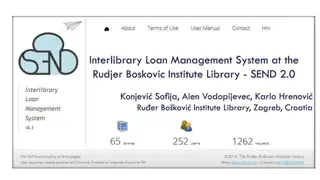Education SEND
Dive into the statutory guidance, challenges, and curriculum expectations for delivering Relationships and Sex Education (RSE) in a Special Educational Needs and Disabilities (SEND) context. Gain insights on tailoring content, meeting developmental needs, and linking lesson outcomes to statutory preparations. Be prepared to make RSE accessible and sensitive to all pupils in your school.
Download Presentation

Please find below an Image/Link to download the presentation.
The content on the website is provided AS IS for your information and personal use only. It may not be sold, licensed, or shared on other websites without obtaining consent from the author.If you encounter any issues during the download, it is possible that the publisher has removed the file from their server.
You are allowed to download the files provided on this website for personal or commercial use, subject to the condition that they are used lawfully. All files are the property of their respective owners.
The content on the website is provided AS IS for your information and personal use only. It may not be sold, licensed, or shared on other websites without obtaining consent from the author.
E N D
Presentation Transcript
Relationship and Sex Education SEND Webinar 28 January 2021
Todays Aims be aware of what is included in the statutory guidance be aware of the opportunities and challenges in delivering RSE in a SEND context understand the process of designing an RSE curriculum for pupils with SEND feel more confident about delivering RSE for pupils with SEND
Who are we? Dan Pearce and Pippa Hinchliffe Deputy Principal and Assistant Principal, Castle Hill School Castle Hill School context and cohort
Who are you? Briefly introduce yourself and school. How far in your RSE journey are you? What do you hope to get from the webinar?
Guidance Relationships Education, Relationships and Sex Education (RSE) and Health Education policy from the DfE 2019 (updated 2020) Timescale originally for implementation by September 2020, now by Summer term 2021 Content Primary and Secondary Expectations Primary Relationships Education Secondary Relationships and Sex Education
SEND context and challenges STATUTORY GUIDANCE Relationships Education, RSE and Health Education must be accessible for all pupils there may be a need to tailor content and teaching to meet the specific needs of pupils at different developmental stages. As with all teaching for these subjects, schools should ensure that their teaching is sensitive, age-appropriate, developmentally appropriate and delivered with reference to the law. (See Relationships Education, Relationships and Sex Education (RSE) and Health Education Statutory Guidance, page 15) Barriers in communication, difficulties in reading body language and/or picking up social cues, difficulties in understanding what is and is not appropriate behaviour, discrepancies between age and level of cognition You might want to link lesson outcomes with statutory preparing for adulthood outcomes for those with an education, health and care (EHC) plan. (See SEND code of practice, section 8)
Curriculum expectations Primary Families and people who care for me Caring friendships Secondary Families Respectful relationships, including friendships Online and media Being safe Intimate and sexual relationships, including sexual health Respectful relationships Online relationships Being safe
Parents Withdrawal Parents have the right to request that their child be withdrawn from some or all of sex education delivered as part of statutory RSE. Before granting any such request, it would be good practice for the head teacher to discuss the request with parents to clarify the nature and purpose of the curriculum. Schools will want to document this process to ensure a record is kept. (See Relationships Education, Relationships and Sex Education (RSE) and Health Education Statutory Guidance, page 17) Engagement Formal and less formal ways of engaging families e.g. working parties (formal) or coffee mornings (less formal) to discuss the curriculum intent and delivery Consultations and Policy Consultations should take place with parents (see example letter), governors, staff and perhaps other schools
Action Plan What do we need to put in place as we move towards delivery of RSE? Family engagement Information gathering Policy/policy review Programme of study Resources Training Sharing of information with stakeholders Further support Reviewing delivery
Policy Mandatory to have a RSE policy, available to all Include content of the RSE curriculum area and how it is taught Describe how the RSE curriculum area is monitored and evaluated Information on mandatory areas and those that pupils can be withdrawn from (SE in secondary)
Policy Our policy is currently being ratified by our Local Governing Body and includes: General policy statements (including Unicef Articles) RSE Philosophy Families, equality, faith Practice and delivery Age differentiation and curriculum content Monitoring and evaluation Staff guidelines and support
Curriculum and SEND Differences between Primary and Secondary curriculum Curriculum coverage - part of discrete lesson or cross-curricular Child centred approach Appropriateness for age and cognitive ability For pupils with PMLD/SLD the focus of RSE should be on relationship aspects and the application of a total communication approach to enable pupils to make choices and understand what is happening to them
Curriculum and SEND Language should be simple and relevant All communication should be backed up by symbols/photographs/words appropriate to the pupils communication needs To support generalisation and consolidation of skills pupils with SEND should be provided with opportunities to practice the same skills in different contexts. Therefore it would be appropriate to complete similar tasks under different module headings, such as: reinforcing yes/no communication; matching activities; sequencing of events; understanding changes
Where does RSE fit? PSHE Safeguarding Policy Total Communication Approach RSE Online safety Other curriculum areas e.g. science, computing, citizenship Use of Touch Policy Positive Behaviour Policy Anti-bullying Policy
Curriculum Areas Looking at common areas of the Primary and Secondary Curricula Addressing points of difference
Families and people who care for me / Families Identifying / recognising family members by photograph or voice (the use of a Big Mack switch can support with family voice recognition) Sharing of news, sharing celebrations, school occasions, opportunities for families and school to join together Recognising and respecting difference in families, such as same-sex relationships, single-parent families, children who live with grandparents Understanding and expressing emotions Looking after others roleplay, pet therapy, childcare Allowing therapists and professionals to provide support and interventions
Caring friendships / Respectful relationships Taking part in shared exploration of an object with a friend Helping a friend use a tool, guiding their hand Embracing differences in others Respecting the choices of peers Demonstrating flexibility when working with others, for example, allowing someone to play with a desired item first Responding to the sounds / actions of peers (taking part in Intensive Interaction strategies with a peer) Understanding others feelings and accepting differences Praising peers and celebrating their achievements
Online relationships / Online and media Supporting families to keep their child safe - the use of technology in their presence Learning to tell a trusted adult if something happens online that they are unsure about or makes them feel uncomfortable (some schools have a symbol on students computer screens that they can click to block the screen) Recognising the danger of talking to strangers on the internet Learning what is meant by personal information , such as full name, school, address and recognising the importance of not sharing this information online Recognising that people can impersonate someone else online
Being Safe Having a respect for the pupil voice in all its forms Making choices, being able to say yes or no Now and next understanding and feeling comfortable within routines Use of appropriate touch Asking for help no communication opportunity to go unheeded Matching activities with objects/photos e.g. safe and not safe
Intimate and sexual relationships, inc. sexual health Cognitively appropriate not all will be able to understand issues relating to their body, but all will be able to impact their world in a meaningful way What will benefit that individual understanding changes, working towards their future (EHCP), hygiene What is the key vocabulary: e.g. baby, boy, girl, man, lady, young, old, body parts Bodies Activity: use photographs/pictures of self or familiar people at different stages in life. Match names to faces, sequence pictures in a chronological order Draw round yourself label body parts with photos/symbols/pre written words (keep language simple) Bag of items: Explore the objects in the bag, use items for sensory play Keep it simple - discuss private spaces and public spaces. What can we share in public spaces? What is only for private spaces?
Delivery Sharing of curriculum and resources The lead teacher should work closely with colleagues in related curriculum areas to ensure the RSE teaching complements, and does not duplicate, content covered in other national curriculum subjects such as citizenship, science and computing. It is important to check prior knowledge and build this into the planning process to ensure a smooth transition between Primary and Secondary. A resource bank, which is quality assured by the lead teacher would help support other colleagues.
